Great Planes GPMA1219 User Manual
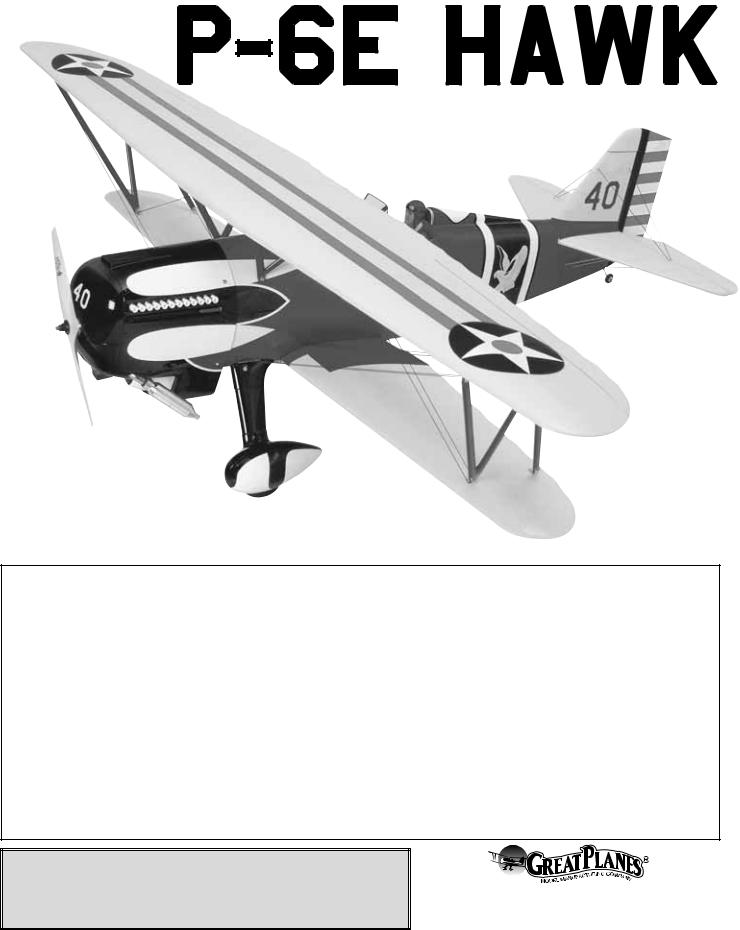
INSTRUCTION MANUAL
Wingspan: Top Wing - 76 in [1930mm] Bottom Wing - 63 in [1600mm]
Wing Area: Top Wing - 852 sq in [55 dm2] Bottom Wing - 589 sq in [38 dm2]
Weight: 14–16 lb [6348 – 7255 g]
Wing Loading: 22–26 oz/sq ft [67-79 g/dm2] Length: 59.75 in [1518mm]
Radio: 4-channel with 5 servos
Engine: .91-1.08 cu in [15-17.5cc] two-stroke,
.91-1.20 cu in [19.5-23cc] four-stroke
WARRANTY
Great Planes® Model Manufacturing Co. guarantees this kit to be free from defects in both material and workmanship at the date of purchase. This warranty does not cover any component parts damaged by use or modification. In no case shall Great Planes’ liability exceed the original cost of the purchased kit. Further, Great Planes reserves the right to change or modify this warranty without notice.
In that Great Planes has no control over the final assembly or material used for final assembly, no liability shall be assumed nor accepted for any damage resulting from the use by the user of the final user-assembled product. By the act of using the user-assembled product, the user accepts all resulting liability.
If the buyer is not prepared to accept the liability associated with the use of this product, the buyer is advised to return this kit immediately in new and unused condition to the place of purchase.
To make a warranty claim send the defective part or item to Hobby Services at the address below:
Hobby Services
3002 N. Apollo Dr. Suite 1
Champaign IL 61822 USA
Include a letter stating your name, return shipping address, as much contact information as possible (daytime telephone number, fax number, e-mail address), a detailed description of the problem and a photocopy of the purchase receipt. Upon receipt of the package the problem will be evaluated as quickly as possible.
READ THROUGH THIS MANUAL BEFORE STARTING CONSTRUCTION. IT CONTAINS IMPORTANT WARNINGS AND INSTRUCTIONS CONCERNING THE ASSEMBLY AND USE OF THIS MODEL.
Champaign, Illinois
(217) 398-8970, Ext 5 airsupport@greatplanes.com
© Copyright 2005 |
GPMZ0180 for GPMA1219 V1.1 |
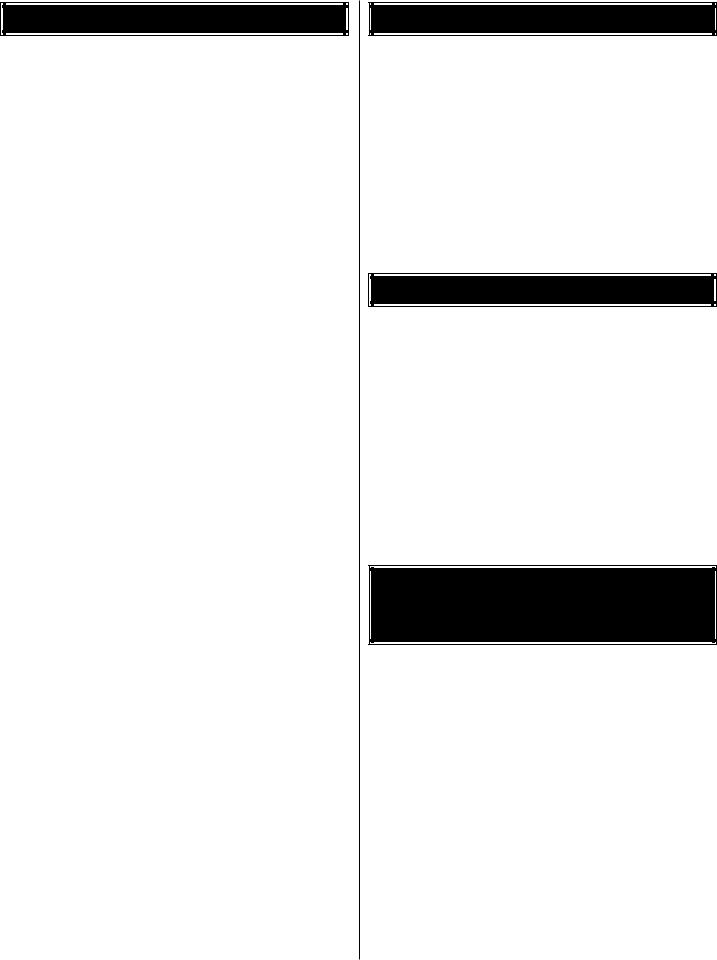
TABLE OF CONTENTS |
|
INTRODUCTION ............................................................... |
2 |
IMAA.................................................................................. |
2 |
SAFETY PRECAUTIONS.................................................. |
2 |
ADDITIONAL ITEMS REQUIRED..................................... |
3 |
Hardware & Accessories............................................. |
3 |
Adhesives & Building Supplies.................................... |
3 |
Optional Supplies & Tools ........................................... |
4 |
IMPORTANT BUILDING NOTES ...................................... |
4 |
INFORMATION ABOUT WORKING WITH FIBERGLASS ... |
4 |
KIT INSPECTION .............................................................. |
5 |
KIT CONTENTS ................................................................ |
5 |
ORDERING REPLACEMENT PARTS .............................. |
6 |
PREPARATIONS ............................................................... |
7 |
BUILD THE WINGS ........................................................... |
7 |
Installing the Ailerons .................................................. |
7 |
Join The Top Wing Panels ........................................... |
8 |
Join The Bottom Wing Panels ..................................... |
8 |
Install The Bottom Wing .............................................. |
9 |
INSTALL THE STABILIZER AND FIN ............................ |
10 |
Install The Stabilizer And Elevator............................. |
10 |
Install The Fin And Rudder ....................................... |
10 |
INSTALL THE MAIN LANDING GEAR........................... |
12 |
INSTALL THE ENGINE ................................................... |
13 |
Mount The Engine ..................................................... |
13 |
Mount The Cowl ........................................................ |
14 |
Install The Fuel Tank ................................................. |
15 |
Install The Throttle Servo .......................................... |
16 |
Finish Assembling The Cowl ..................................... |
17 |
INSTALL THE RADIO SYSTEM...................................... |
18 |
Install The Rudder And Elevator Servos ................... |
18 |
Install The Aileron Servos & Pushrods...................... |
21 |
INSTALL THE TOP WING................................................ |
22 |
FINISH THE FUSELAGE................................................. |
23 |
Build The Carrying Handle ........................................ |
23 |
Assemble The Nose Weight Box............................... |
25 |
Finishing Touches...................................................... |
25 |
Optional Flying Wire Installation................................ |
26 |
Apply The Decals ...................................................... |
29 |
GET THE MODEL READY TO FLY ................................. |
30 |
Check the Control Directions .................................... |
30 |
Set the Control Throws.............................................. |
30 |
Balance the Model (C.G.).......................................... |
30 |
Balance the Model Laterally...................................... |
31 |
PREFLIGHT..................................................................... |
31 |
Identify Your Model .................................................... |
31 |
Charge the Batteries ................................................. |
31 |
Balance the Propellers .............................................. |
32 |
Ground Check ........................................................... |
32 |
Range Check............................................................. |
32 |
ENGINE SAFETY PRECAUTIONS................................. |
32 |
AMA SAFETY CODE (EXCERPTS).................................... |
33 |
IMAA SAFETY CODE (EXCERPTS)................................... |
33 |
CHECK LIST ................................................................... |
34 |
FLYING ............................................................................ |
34 |
Fuel Mixture Adjustments.......................................... |
34 |
Take Off ..................................................................... |
34 |
Flight.......................................................................... |
35 |
Landing...................................................................... |
35 |
INTRODUCTION
The P-6E Hawk has a long and colorful history in both the U.S. military and abroad. You will thoroughly enjoy the wide range of capabilities of this plane as well as its good looks. We think you will be pleased with its attention to detail and flight characteristics.
For the latest technical updates or manual corrections to the P-6E Hawk ARF, visit the Great Planes web site at www.greatplanes.com. Open the “Airplanes” link, then select the P-6E Hawk ARF. If there is new technical information or changes to this model a “tech notice” box will appear in the upper left corner of the page.
IMAA
The P-6E Hawk ARF is an excellent sport-scale model and is eligible to fly in IMAA events. The IMAA (International Miniature Aircraft Association) is an organization that promotes non-competitive flying of giant-scale models. If you plan to attend an IMAA event, obtain a copy of the IMAA Safety Code by contacting the IMAA at the address or telephone number below, or by logging on to their web site at www.fly-imaa.org/imaa/sanction.html.
IMAA
205 S. Hilldale Road
Salina, KS 67401
(913) 823-5569
PROTECT YOUR MODEL, YOURSELF & OTHERS...FOLLOW THESE IMPORTANT SAFETY PRECAUTIONS
1.Your P-6E Hawk ARF should not be considered a toy, but rather a sophisticated, working model that functions very much like a full-size airplane. Because of its performance capabilities, the P-6E Hawk ARF, if not assembled and operated correctly, could possibly cause injury to yourself or spectators and damage to property.
2.You must assemble the model according to the instructions. Do not alter or modify the model, as doing so may result in an unsafe or unflyable model. In a few cases the instructions may differ slightly from the photos. In those instances the written instructions should be considered as correct.
3.You must take time to build straight, true and strong.
4.You must use an R/C radio system that is in first-class condition, and a correctly sized engine and components (fuel tank, wheels, etc.) throughout the building process.
2
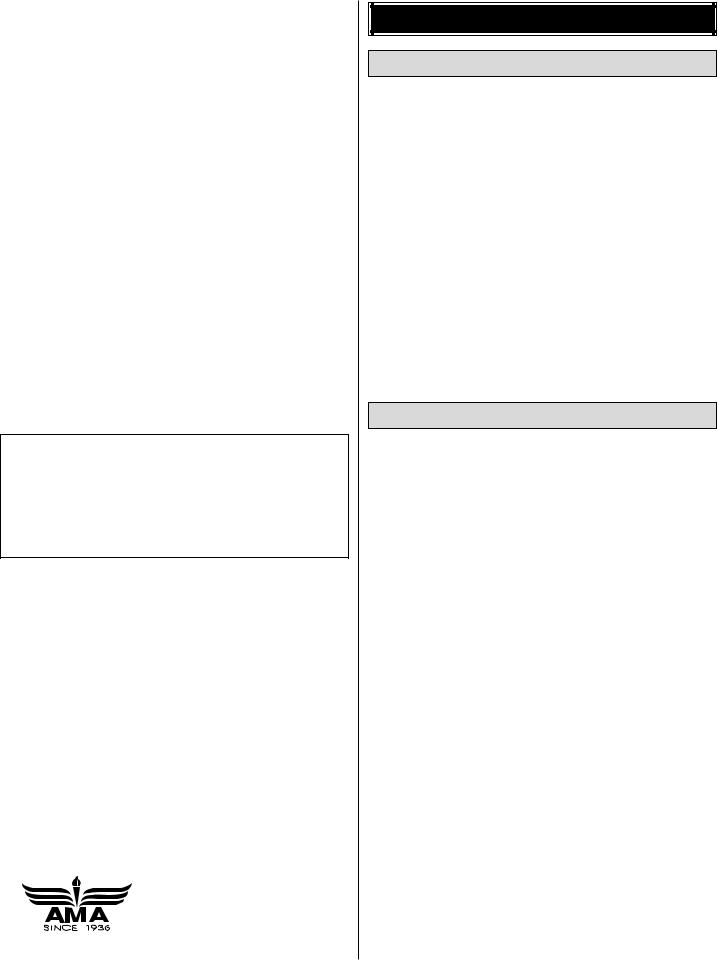
5.You must correctly install all R/C and other components so that the model operates correctly on the ground and in the air.
6.You must check the operation of the model before every flight to insure that all equipment is operating and that the model has remained structurally sound. Be sure to check clevises or other connectors often and replace them if they show any signs of wear or fatigue.
7.If you are not already an experienced R/C pilot, you should fly the model only with the help of a competent, experienced R/C pilot.
8.While this kit has been flight tested to exceed normal use, if the plane will be used for extremely high stress flying, such as racing, the modeler is responsible for taking steps to reinforce the high stress points.
9.WARNING: The cowl, landing gear covers and wing struts included in this kit are made of fiberglass, the fibers of which may cause eye, skin and respiratory tract irritation. Never blow into a part to remove fiberglass dust, as the dust will blow back into your eyes. Always wear safety goggles, a particle mask and rubber gloves when grinding, drilling and sanding fiberglass parts. Vacuum the parts and the work area thoroughly after working with fiberglass parts.
Note: We, as the kit manufacturer, provide you with a top quality kit and great instructions, but ultimately the quality of your finished model depends on how you build it; therefore, we cannot in any way guarantee the performance of your completed model, and no representations are expressed or implied as to the performance or safety of your completed model.
Remember:Take your time and follow the instructions to end up with a well-built model that is straight and true.
If you have not flown this type of model before, we recommend that you get the assistance of an experienced pilot in your R/C club for your first flights. If you’re not a member of a club, your local hobby shop has information about clubs in your area whose membership includes experienced pilots.
In addition to joining an R/C club, we strongly recommend you join the AMA (Academy of Model Aeronautics). AMA membership is required to fly at AMA sanctioned clubs. There are over 2,500 AMA chartered clubs across the country. Among other benefits, the AMA provides insurance to its members who fly at sanctioned sites and events. Additionally, training programs and instructors are available at AMA club sites to help you get started the right way. Contact the AMA at the address or toll-free phone number that follows.
Academy of Model Aeronautics
5151 East Memorial Drive
Muncie, IN 47302-9252
Tele. (800) 435-9262 Fax (765) 741-0057
Or via the Internet at: http://www.modelaircraft.org
ADDITIONAL ITEMS REQUIRED
Hardware and Accessories
This is the list of hardware and accessories required to finish the P-6E Hawk. Order numbers are provided in parentheses.
Engine (refer to the engine size requirements on the cover of the manual)
4-Channel radio
(1) standard servo (throttle)
(4) servos with minimum of 54 oz/in torque (2-ailerons, 1-elevator, 1-rudder)
(2) 6" [300mm] servo extensions (for aileron servos, HCAM2701 for Futaba®)
(1) Y-harness (for aileron servos, HCAM2751for Futaba)
(1) minimum 1,000mAh receiver battery
Propeller and spare propellers (refer to your engine manufacturer’s recommendations)
Adhesives and Building Supplies
In addition to common household tools and hobby tools, this is the “short list” of the most important items required to build the P-6E Hawk ARF. Great Planes Pro™ CA and Epoxy glue are recommended.
R/C foam rubber (1/4" [6mm] – HCAQ1000, or 1/2" [13mm] – HCAQ1050)
1 oz. [30g] Thin Pro CA (GPMR6002)
1 oz. [30g] Medium Pro CA+ (GPMR6008)
Pro 30-minute epoxy (GPMR6047)
Pro 6-minute epoxy (GPMR6045)
Threadlocker™ thread-locking cement (GPMR6060)
Drill bits: 1/16" [1.6mm], 5/64" [2mm], 3/32" [2.4mm], 1/8" [3mm], #29 or 9/64" [3.6mm], 3/16" [4.8mm], 7/32" [5.5mm]
8-32 tap
1/2" wrench
Hex head wrench set
5 pkgs Stick-on segmented lead weights (GPMQ4485)
#1 Hobby knife (HCAR0105)
#11 Blades (5-pack, HCAR0211)
Small T-pins (100, HCAR5100)
R/C-56 canopy glue (JOZR5007)
CA applicator tips (HCAR3780)
Denatured alcohol (for epoxy cleanup)
Curved-tip canopy scissors for trimming plastic parts (HCAR0667)
3
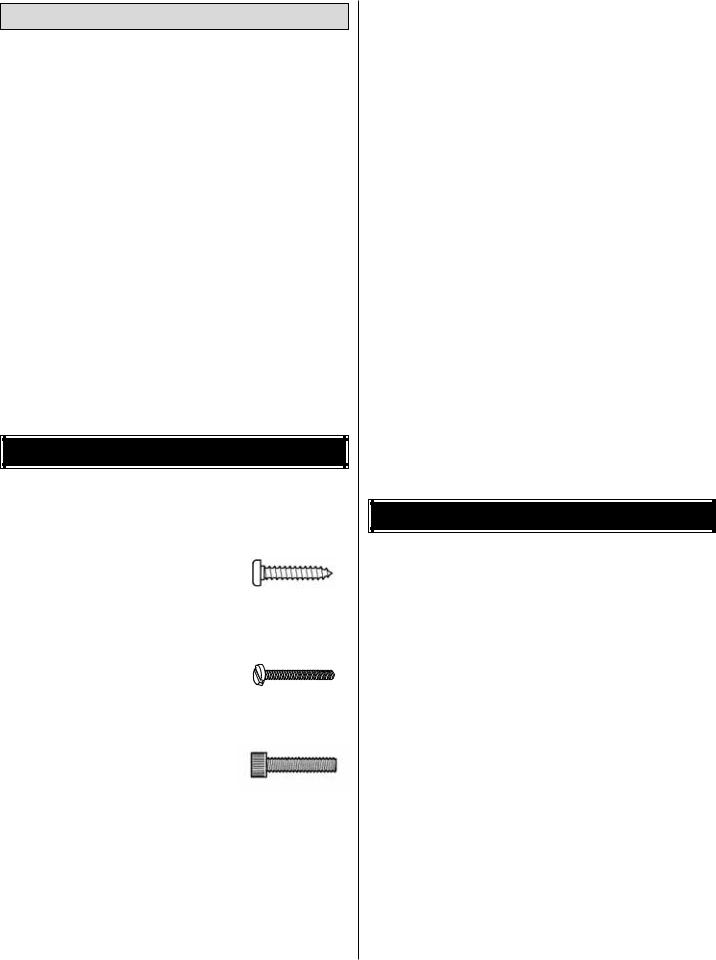
Optional Supplies and Tools
Here is a list of optional tools mentioned in the manual that will help you build the P-6E Hawk ARF.
2 oz. [57g] spray CA activator (GPMR6035) or
4 oz. [113g] aerosol CA activator (GPMR634)
Epoxy brushes (6, GPMR8060)
Mixing sticks (50, GPMR8055)
Mixing cups (GPMR8056)
Builder’s Triangle Set (HCAR0480)
Pliers with wire cutter (HCAR0630)
Robart Super Stand II (ROBP1402)
Hobbico® Duster™ can of compressed air (HCAR5500)
Masking tape (TOPR8018)
Microballoons (TOPR1090)
Rotary tool such as Dremel®
Rotary tool reinforced cut-off wheel (GPMR8200)
Servo horn drill (HCAR0698)
Dead Center™ Engine Mount Hole Locator (GPMR8130)
AccuThrow™ Deflection Gauge (GPMR2405)
CG Machine™ (GPMR2400)
Precision Magnetic Prop Balancer™ (TOPQ5700)
Fuel filler valve for glow fuel (GPMQ4160)
IMPORTANT BUILDING NOTES
• There are two types of screws used in this kit:
Sheet metal screws are designated by a number and a length. For example #6 x 3/4" [19mm]
This is a number six screw that is 3/4" [19mm] long.
Machine screws are designated by a number, threads per inch and a length. For example 4-40 x 3/4" [19mm]
This is a number four screw that is 3/4" [19mm] long with forty threads per inch.
Socket head cap screws are designated by a number, threads per inch and a length. For example 4-40 x 3/4" [19mm]
This is a number four screw that is 3/4" [19mm] long with forty threads per inch.
•When you see the term test fit in the instructions, it means that you should first position the part on the assembly without using any glue, then slightly modify or custom fit the part as necessary for the best fit.
•Whenever the term glue is written you should rely upon your experience to decide what type of glue to use. When a specific type of adhesive works best for that step, the instructions will make a recommendation.
•Photos and sketches are placed before the step they refer to. Frequently you can study photos in following steps to get another view of the same parts.
•The P-6E Hawk ARF is factory-covered with Top Flite® MonoKote® film. Should repairs ever be required, MonoKote can be patched with additional MonoKote purchased separately. MonoKote is packaged in six-foot rolls, but some hobby shops also sell it by the foot. If only a small piece of MonoKote is needed for a minor patch, perhaps a fellow modeler would give you some. MonoKote is applied with a model airplane covering iron, but in an emergency a regular iron could be used. A roll of MonoKote includes full instructions for application. Following are the colors used on this model and order numbers for six foot rolls.
Cub Yellow – TOPQ0220 |
Black – TOPQ0208 |
Olive Drab – TOPQ0210 |
Dark Red – TOPQ0218 |
White – TOPQ0204 |
|
•The stabilizer and wing incidences and engine thrust angles have been factory-built into this model. However, some technically minded modelers may wish to check these measurements anyway. To view this information visit the web site at www.greatplanes.com and click on “Technical Data.” Due to manufacturing tolerances which will have little or no effect on the way your model will fly, please expect slight deviations between your model and the published values.
WORKING WITH FIBERGLASS
If you have never worked with fiberglass there are a few basic things you should be aware of.
1.When you are cutting into fiberglass, be sure you are cutting the correct place. Unlike wood, you are not able to go back and easily fix a mistake.
2.Whenever you are gluing a part to the inside of fiberglass it is important to roughen the inside surface of the fiberglass with 220-grit sandpaper, then wipe the area with alcohol. The molding process leaves a waxy residue that can prevent a good bond between the glue and the parts being glued.
3.If you do not have a high-speed rotary tool such as a Dremel tool, you should consider purchasing one or borrowing one from a fellow modeler. This combined with a fiberglass cut-off wheel is going to be extremely helpful in the assembly process.
WARNING: The cowl, landing gear covers and wing struts included in this kit are made of fiberglass, the fibers of which may cause eye, skin and respiratory tract irritation. Never blow into a part to remove fiberglass dust, as the dust will blow back into your eyes. Always wear safety goggles, a particle mask and rubber gloves when grinding, drilling and sanding fiberglass parts. Vacuum the parts and the work area thoroughly after working with fiberglass parts.
4
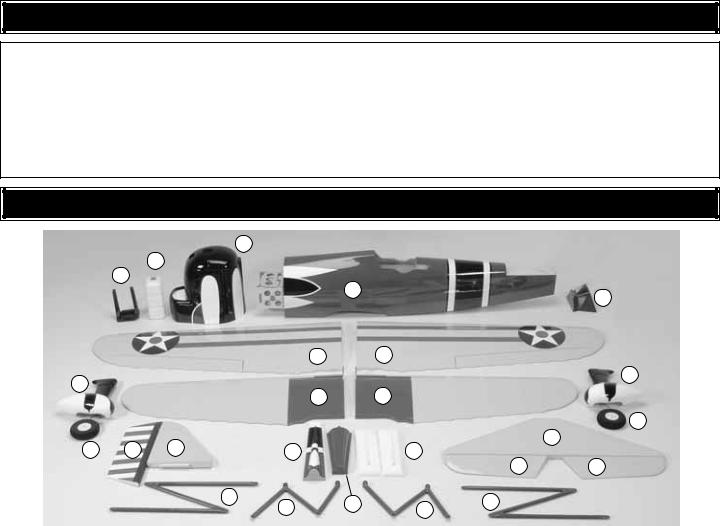
KIT INSPECTION
Before starting to build, take an inventory of this kit to make sure it is complete, and inspect the parts to make sure they are of acceptable quality. If any parts are missing or are not of acceptable quality, or if you need assistance with assembly, contact Great Planes Product Support. When reporting defective or missing parts, use the part names exactly as they are written in the Kit Contents list on this page.
Great Planes Product Support: Telephone: (217) 398-8970, ext. 5 Fax: (217) 398-7721
E-mail: airsupport@greatplanes.com
KIT CONTENTS
|
|
|
|
|
11 |
|
|
|
|
|
|
|
|
|
14 |
|
|
|
|
|
|
|
|
|
|
20 |
|
|
|
|
|
|
|
|
|
|
|
|
|
|
|
|
5 |
|
|
19 |
|
|
|
|
|
|
|
|
|
|
|
|
|
|
|
|
|
|
|
1 |
|
2 |
|
|
|
|
|
21 |
|
|
|
|
|
|
|
21 |
|
|
|
|
|
|
|
|
|
|
|
|
|
|
|
|
|
|
|
3 |
|
4 |
|
|
|
|
|
|
|
|
|
|
|
|
|
13 |
|
|
|
|
|
7 |
|
|
|
|
|
6 |
|
|
|
13 |
9 |
|
18 |
|
12 |
|
|
|
|
|
|
|
|
|
|
|
|
|
8 |
8 |
|
|
|
|
|
|
15 |
16 |
10 |
15 |
|
|
|
|
|
|
|
|
|
|
|
||||
|
|
|
|
|
|
|
17 |
|
|
|
|
|
|
|
|
|
|
|
|
|
|
||
|
|
|
|
|
|
|
|
|
|
||
|
|
|
|
|
|
Kit Contents (Photographed) |
|
|
|
||
1 |
Left Top Wing |
|
|
8 |
Elevators (2) |
|
|
15 “N” Struts (2) |
|||
2 |
Right Top Wing |
|
|
9 |
Rudder |
|
|
16 Left Center Cabane |
|||
3 |
Left Bottom Wing |
|
|
10 Fin Cover |
|
|
17 Right Center Cabane |
||||
4 |
Right Bottom Wing |
|
|
11 Cowl |
|
|
18 Turtle Deck |
||||
5 |
Fuselage |
|
|
12 Molded Exhaust (2) |
19 Wind Screen |
||||||
6 |
Stabilizer |
|
|
13 4" Foam Wheels (2) |
20 Engine Mount Halves (L&R) |
||||||
7 |
Fin |
|
|
14 Fuel Tank |
|
|
21 Landing Gear Cover |
||||
|
|
|
|
|
|
|
|
|
|||
|
|
|
|
|
|
|
|
|
|||
|
|
|
|
|
Kit Contents (Not Photographed) |
|
|
|
|||
Forward Top Wing Joiner (3) |
|
Handle Ends (8) |
|
4-40 x 1/2" SHC Screw (20) |
4-40 x 36" Threaded One End |
||||||
Forward Bottom Wing Joiner (3) |
|
Handle Spreaders (8) |
|
4-40 x 3/4" SHC Screw (4) |
Pushrod (3) |
||||||
Aft Top Wing Joiner (1) |
|
|
Handle Centers (4) |
|
#4 Lock Washer (12) |
|
2-56 x 17-1/2" Threaded One |
||||
Aft Bottom Wing Joiner (1) |
|
Weight Box Bottom (1) |
|
#4 Nylon Lock Nut (8) |
|
End Pushrod (1) |
|||||
Tail Gear Wire w/Bushing (1) |
|
Weight Box Top (1) |
|
#4 Flat Washer (28) |
|
Nylon Clevis (1) |
|||||
Aluminum Landing Gear (1) |
|
Weight Box Front (1) |
|
3/16" Axles (2) |
|
Brass Pushrod Connector (1) |
|||||
Guns (2) |
|
|
Weight Box Back (1) |
|
3/16" Wheel Collars (4) |
|
Nylon Pushrod Keeper (1) |
||||
Stopper Set (1) |
|
|
Weight Box Sides (2) |
|
6-32 Set Screws (2) |
|
4-40 x 1/4" SHC screw (1) |
||||
Clunks (2) |
|
|
Weight Box Sticks (2) |
|
Nylon Axle Nut (2) |
|
24" Gray Outer Prod Tube (1) |
||||
Aluminum Tubes (3) |
|
|
Cockpit Coaming (1) |
|
#2 x 3/8" Sheet Metal Screw (2) |
6-32 x 1/4" SHC Screw (2) |
|||||
Colored Fuel Tubing (3) |
|
Pilot (1) |
|
|
#2 Flat Washer (2) |
|
Hinge Strip (1) |
||||
Pickup Tube (2) |
|
|
1" Tail Wheel (1) |
|
#4 x 1/2" SMS (32) |
|
1/4-20 x 2" Nylon Wing Bolts (2) |
||||
Radio Tray (1) |
|
|
#8 x 5/8" Sheet Metal Screw |
|
4-40 x 12" Pushrod (2) |
|
1/4-20 Blind Nuts (2) |
||||
6.4x6.4x44mm Hardwood |
|
8-32 Blind Nuts (4) |
|
Large Control Horn (5) |
|
3/32" Wheel Collar (1) |
|||||
Stick (4) |
|
|
8-32 x 1-1/4" SHC Screw (4) |
|
4-40 Threaded Metal Clevis (5) |
4-40 Set Screw (1) |
|||||
“N” Strut Brackets (8) |
|
|
#8 Washer (8) |
|
|
.093" Solder Clevis (4) |
|
4-40 Blind Nut (4) |
|||
#64 Rubber Band (3) |
|
|
#8 Lock Washer (8) |
|
4-40 Nut (5) |
|
4-40 x 1" SHC Screw (4) |
||||
Handle Plates (2) |
|
|
8-32 x 1" SHC Screw (4) |
|
Clevis Retainers (10) |
|
|
|
|||
|
|
|
|
|
|
|
|
|
|
|
|
|
|
|
|
|
|
|
5 |
|
|
|
|

ORDERING REPLACEMENT PARTS
Replacement parts for the P-6E Hawk ARF are available using the order numbers in the Replacement Parts List that follows. The fastest, most economical service can be provided by your hobby dealer or mail-order company. Parts may also be ordered directly from Hobby Services, but full retail prices and shipping and handling charges will apply. Illinois and Nevada residents will also be charged sales tax.
To locate a hobby dealer, visit the Great Planes web site at www.greatplanes.com. Choose “Where to Buy” at the bottom of the menu on the left side of the page. Follow the instructions provided on the page to locate a U.S., Canadian or International dealer. If a hobby shop is not available, replacement parts may also be ordered from Tower Hobbies at www.towerhobbies.com, or by calling toll free (800) 637-6050, or from Hobby Services by calling (217) 398-0007, or via facsimile at (217) 398-7721. If ordering via fax, include a Visa® or MasterCard® number and expiration date for payment.
Mail parts orders and payments by personal check to:
Hobby Services
3002 N Apollo Drive, Suite 1
Champaign IL 61822
Be certain to specify the order number exactly as listed in the Replacement Parts List. Payment by credit card or personal check only; no C.O.D.
If additional assistance is required for any reason, contact the appropriate Product Support by telephone at (217) 398-8970 or by e-mail at productsupport@greatplanes.com.
|
Replacement Parts List |
|
Order Number |
Description |
How to Purchase |
|
Missing pieces ................................................ |
Contact Product Support |
|
Instruction manual........................................... |
Contact Product Support |
|
Full-size plans ................................................. |
Not available |
|
Kit parts listed below....................................... |
Hobby Supplier |
GPMA2845............ |
Bottom Wing |
|
GPMA2846............ |
Top Wing |
|
GPMA2847............ |
Fuselage |
|
GPMA2848............ |
Tail Set |
|
GPMA2849............ |
Cowl |
|
GPMA2850............ |
Landing Gear |
|
GPMA2851............ |
Wheel Pants |
|
GPMA2852............ |
Interplane Struts |
|
GPMA2853............ |
Cabane Struts |
|
GPMA2854............ |
Wind Screen |
|
GPMA2855............ |
Decal Set |
|
GPMA2856............ |
Strut Brackets |
|
GPMA2857............ |
Pilot |
|
6
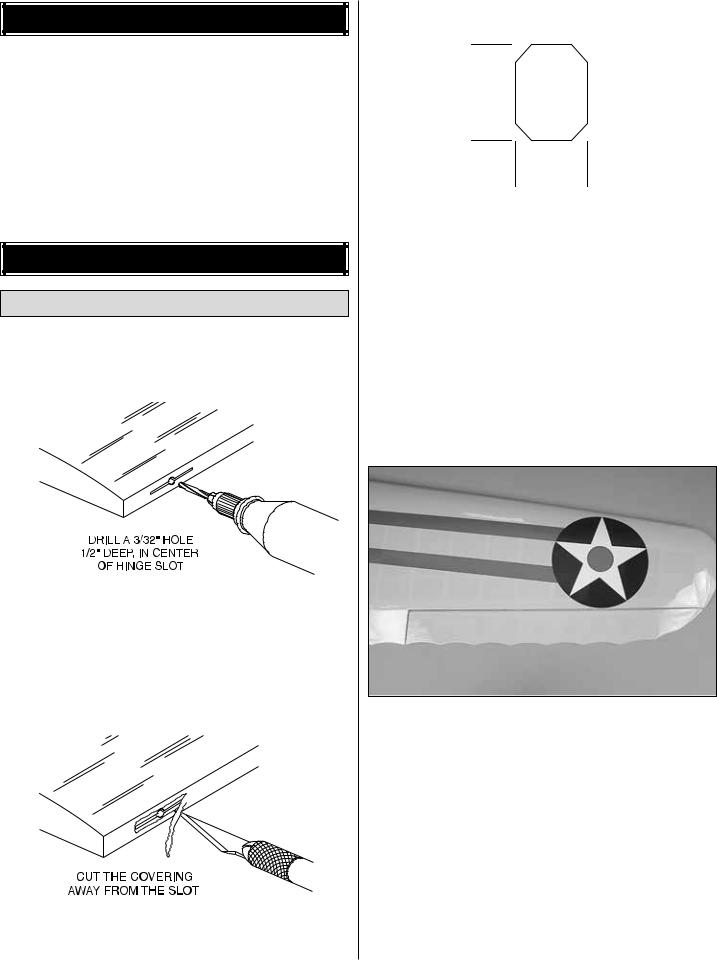
PREPARATIONS
1. If you have not done so already, remove the major parts of the kit from the box and inspect for damage. If any parts are damaged or missing, contact Product Support at the address or telephone number listed in the “Kit Inspection” section on page 5.
2. Remove the tape and separate the ailerons from the wing and the elevators from the stab. Use a covering iron with a covering sock on high heat to tighten the covering if necessary. Apply pressure over sheeted areas to thoroughly bond the covering to the wood.
BUILD THE WINGS
Installing the Ailerons
Do the right top wing first, so your work matches the photos the first time through. You can do one wing at a time, or work on them together.
1. On the right top wing panel, drill a 3/32" [2.4mm] hole, 1/2" [13mm] deep in the center of each hinge slot to allow the CA to “wick” in. Follow-up with a #11 blade to clean out the slots. Hint: If you have one, use a high-speed rotary tool to drill the holes.
2. Use a sharp #11 blade to cut a strip of covering from the hinge slots in the wing and aileron.
7
1"
[25mm]
3/4"
[20mm]
3. Cut four 3/4" x 1" [19 x 25mm] hinges from the CA hinge strip. Snip off the corners so they go in easier.
4. Test fit the ailerons to the wing with the hinges. If the hinges don’t remain centered, stick a pin through the middle of the hinge to hold it in position.
5. Remove any pins you may have inserted into the hinges. Adjust the aileron so there is a small gap between the LE of the aileron and the wing. The gap should be small, just enough to see light through or to slip a piece of paper through.
6. Apply six drops of thin CA to the top and bottom of each hinge. Do not use CA accelerator. After the CA has fully cured, test the hinges by pulling on the aileron.
7. Repeat steps 1- 6 for the left top wing panel.
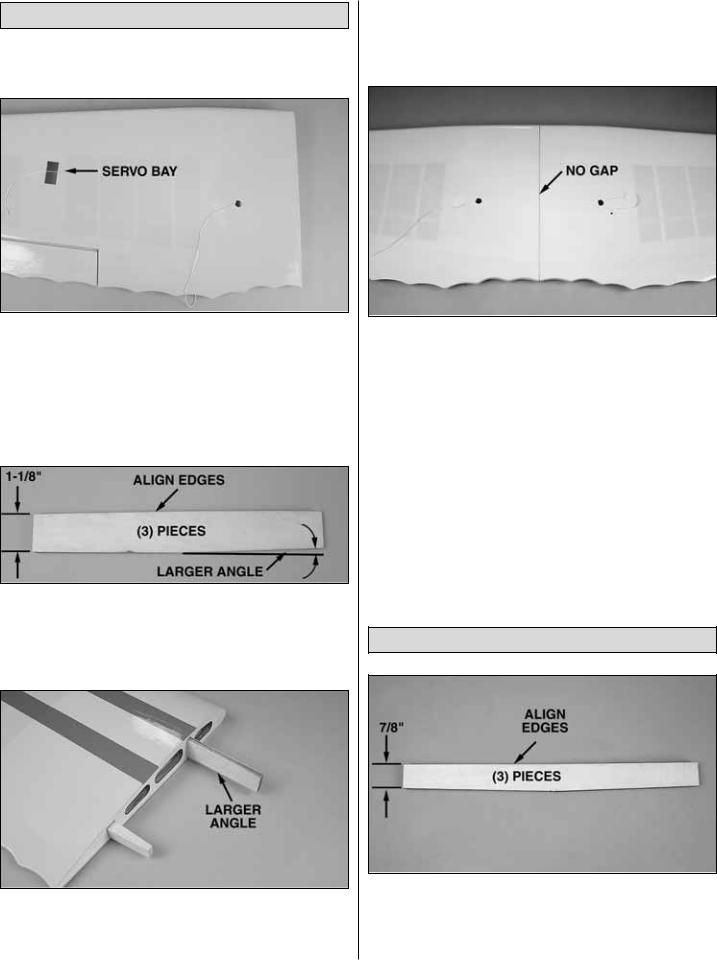
Join the Top Wing Panels
1. Cut away the covering from the servo bay in the bottom of the right top wing panel.
2. A string is taped inside the servo bay. Carefully remove the string from the servo bay and tape it to the outside of the wing to prevent it from dropping back into the wing. The other end of the string is under the hole towards the root of the wing. Remove the covering from over the hole and thread the string through the small hole and tape it to the wing.
3. Repeat steps 1 and 2 for the left top wing panel.
4. Locate two 1/8" [3mm] and one 1/16" [1.5mm] thick by 1-1/8" [28.6mm] wide plywood wing joiners. Using 6-minute epoxy, glue the three joiners together to form one 5/16" [7.5mm] thick wing joiner. Make sure that all three wing joiners are aligned.
5. After the glue has cured, test fit the wing joiner into the top wing panels. Note that the wing joiner has a larger angle on one edge. The larger angle goes toward the bottom of the wing. Also insert the larger hardwood trailing edge wing joiner.
6. To check that the joiners are properly installed, position the top wing upside-down on your flat building surface. The wing should lay flat. If it does not, remove the forward wing joiner, flip it over and reinstall it in the wing panels.
7. When you are satisfied with the fit of the joiners, glue the forward and aft wing joiners into the top wing panels with 30-minute epoxy. Be sure that the forward wing joiner is installed properly. When gluing the wing panels together be sure to get glue into the joiner pockets in the wing. This can be done by applying the glue into the pockets with a small stick. Apply glue to the pockets, the joiners and the root ribs of the wing panels.
Before the glue cures, set the wing upside-down on your flat building surface. Put small weights on the wing to keep it lying flat while the glue cures.
8. Hold the wing together with masking tape while the glue is curing. Before the epoxy cures, the excess epoxy can be removed with denatured alcohol and a paper towel.
Join the Bottom Wing Panels
1. Locate three 1/8" [3mm] and one 1/16" [1.5mm] thick by 7/8" [22mm] wide plywood wing joiners. Using 6-minute epoxy, glue the three joiners together to form one 5/16" [7.5mm] thick wing joiner. Make sure that all three wing joiners are aligned.
8
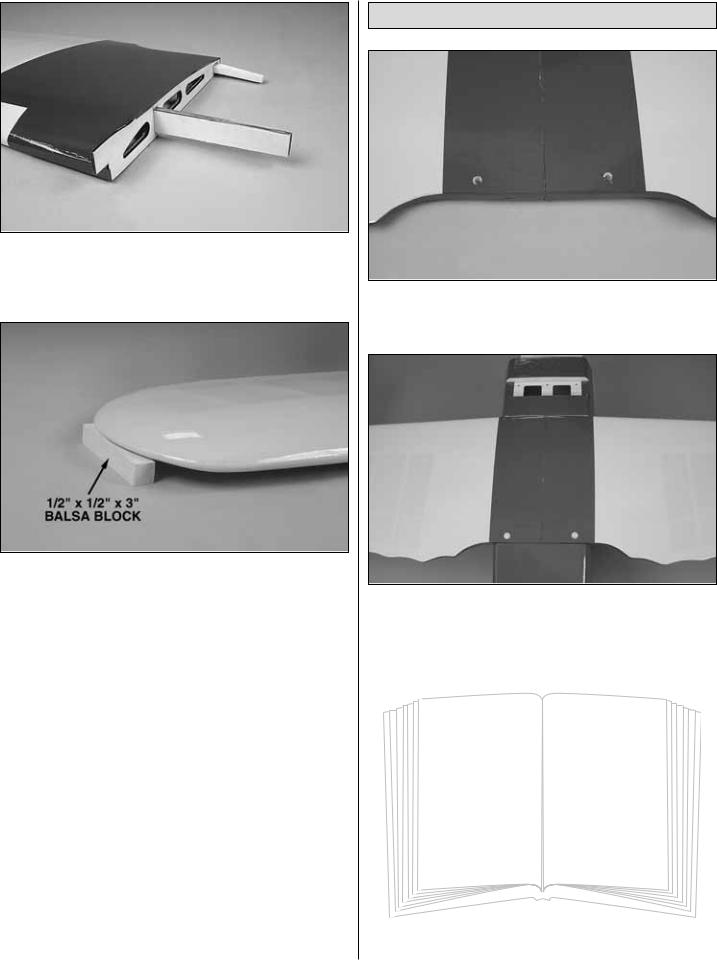
2. After the glue has cured, test fit the wing joiner into the bottom wing panels. Note that the wing joiner is angled to provide dihedral in the bottom wing. Also insert the smaller hardwood trailing edge wing joiner.
3. To check that the joiners are properly installed, position the wing upright on your building surface. Place the included 1/2" x 1/2" x 3" [12.7mm x 12.7mm x76.2mm] balsa block under each wing tip. The center of the wing should be resting on your building table.
4. When you are satisfied with the fit of the joiners, glue the forward and aft wing joiners into the bottom wing panels with 30-minute epoxy. Be sure that the forward wing joiner is installed properly. When gluing the wing panels together be sure to get glue into the joiner pockets in the wing. This can be done by applying the glue into the pockets with a small stick. Apply glue to the pockets, the joiners and the root ribs of the wing panels.
Before the glue cures, set the wing upright on your building surface. Position the two blocks under the wing tips. Put small weights on the wing to keep it lying flat while the glue cures.
5. Hold the wing together with masking tape while the glue is curing. Before the epoxy cures, the excess epoxy can be removed with denatured alcohol and a paper towel.
Install the Bottom Wing
1. Cut the covering from over the two wing bolt mounting holes at the aft edge of the bottom wing.
2. Attach the bottom wing to the fuselage with two 1/4-20 x 2" [50.8mm] nylon bolts.
Did you know? ....
The original P-6 had a designation as XP-6 and was designed for the 1927 National Air Race, placing 2nd with an average speed of 189 mph. The plane that beat
it was the Curtiss XP-6A.
9
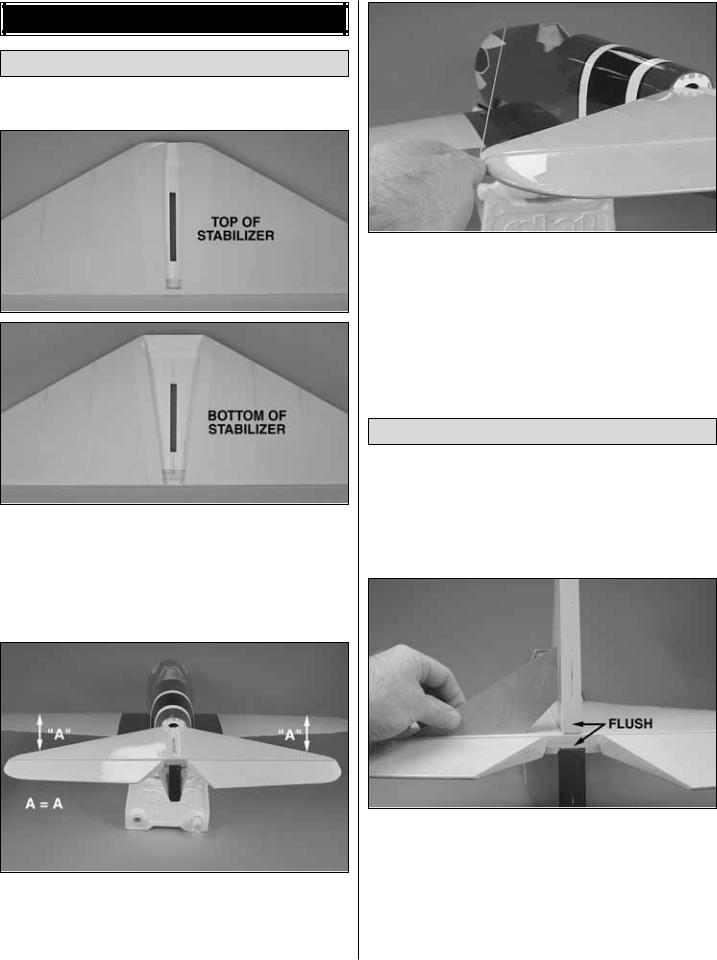
INSTALL THE STABILIZER AND FIN
Install the Stabilizer and Elevator
1. Remove the two elevators from the stabilizer.
2. Trim the covering from the top and bottom of the center of the stabilizer.
3. Cut six 3/4" x 1" [19mm x 25.4mm] hinges from the hinge strip. Install both elevators and hinges on the stabilizer, using the same method that was used to install the ailerons on the wing.
4. Test fit the stabilizer on the fuselage. Note that the cutout in the stabilizer fits over the fuselage. Stand back and look at the stabilizer in relation to the wing. The stabilizer should be parallel with the wing. If not, sand the stabilizer saddle until the stabilizer and wing are aligned.
5. Measure the distance from the tip of the stabilizer to the center of the fuselage at the firewall. Adjust the position of the stabilizer until they are equal.
6. When satisfied with the fit, use 30-minute epoxy to glue the stabilizer to the fuselage. Double-check the stabilizer alignment while the epoxy is curing.
Install the Fin and Rudder
1. Fit the fin in the cutout in the top of the stabilizer. Make sure the bottom of the fin seats against the top of the stabilizer in the cutout. If needed, trim the corners of the alignment block on the bottom of the fin. Make sure the trailing edge of the fin is flush and aligned with the aft end of the fuselage.
2. Use a 90-degree triangle to check that the fin is perpendicular to the stabilizer. This should be checked at the trailing edge of the stabilizer and fin.
3. Use 6-minute epoxy to glue the fin to the stabilizer. Use masking tape to hold the fin in position, double-checking the alignment while the epoxy is curing. Do not glue the front of the fin to the turtledeck. Leave a 1/32" [.8mm] gap between the fin and the turtledeck. The fin cover must fit between the two.
10
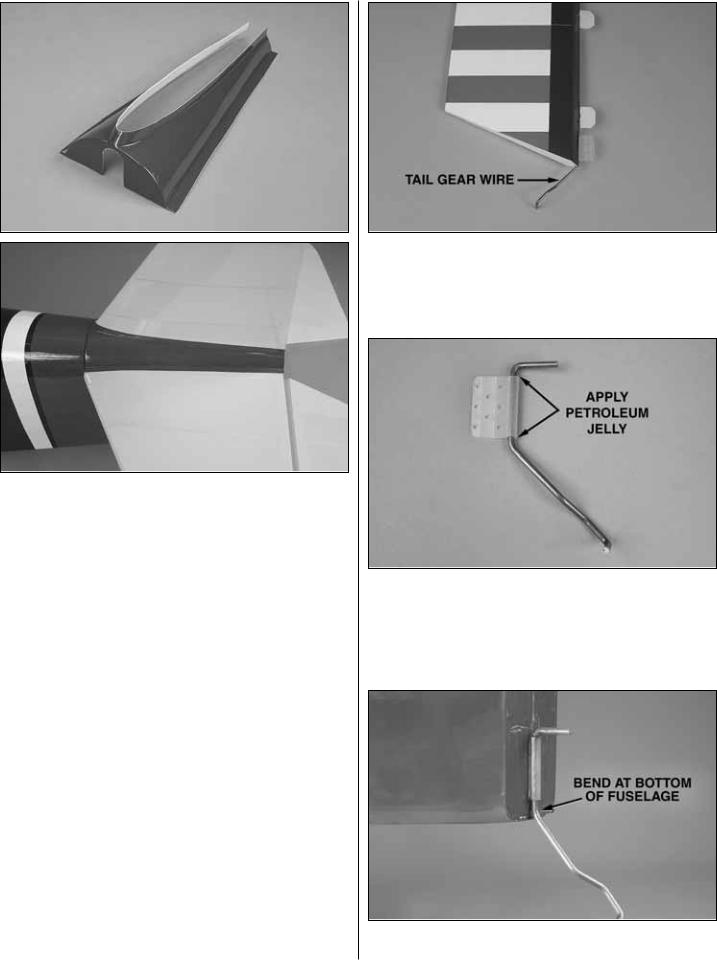
8. Trim the covering from over the slot at the lower leading edge of the rudder. Test fit the tail gear wire in the slot.
4. Use a canopy scissors or hobby knife to trim the plastic fin cover along the molded cut lines. Trial fit the cover over the fin. We found that cutting the front center from the cover allowed the fin to fit better. Trim the aft end of the cover so that it is flush with the trailing edge of the fin.
9. Apply petroleum jelly to the tail gear wire above and below the tail gear bushing. Do not get petroleum jelly on the bushing or the wire that will be glued in the rudder.
5. Use sandpaper to roughen the inside of the cover where it contacts the fin and stabilizer. Mark the outline of the cover on the fin and stabilizer using a felt tip pen. Remove the cover and use a pin to poke small holes where the cover will be attached. This will help the glue adhere to the stabilizer and fin.
6. Glue the cover to the stabilizer, fin and fuselage using CA, epoxy or canopy glue. We prefer to use epoxy or canopy glue to allow time to position the cover and clean off the excess glue. Use masking tape to hold the cover in position until the glue cures.
7. Cut three 3/4" x 1" [19mm x 25.4mm] hinges from the 10. Use epoxy to glue the tail gear bushing in the aft end
hinge strip. Test fit the rudder to the fin and fuselage. |
of the fuselage. |
11
